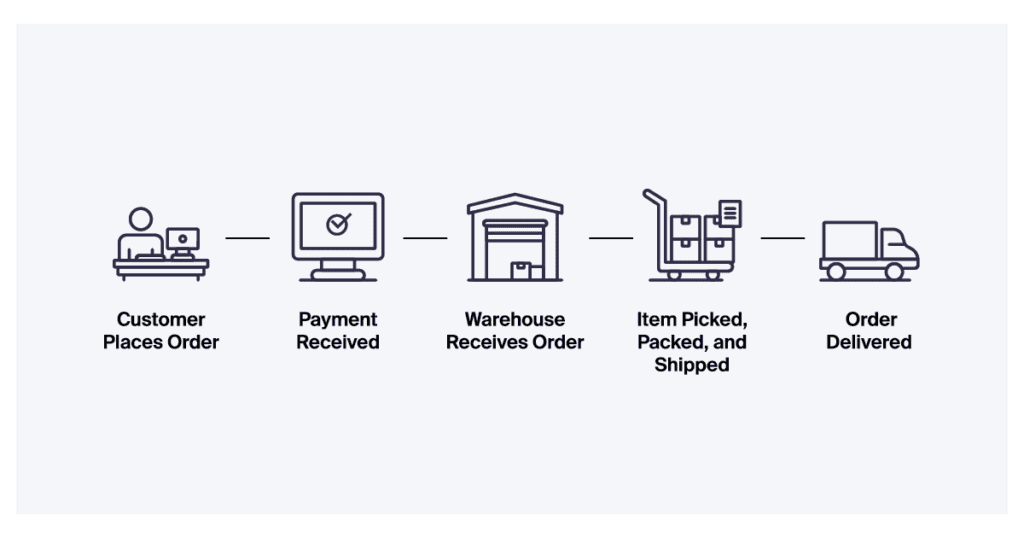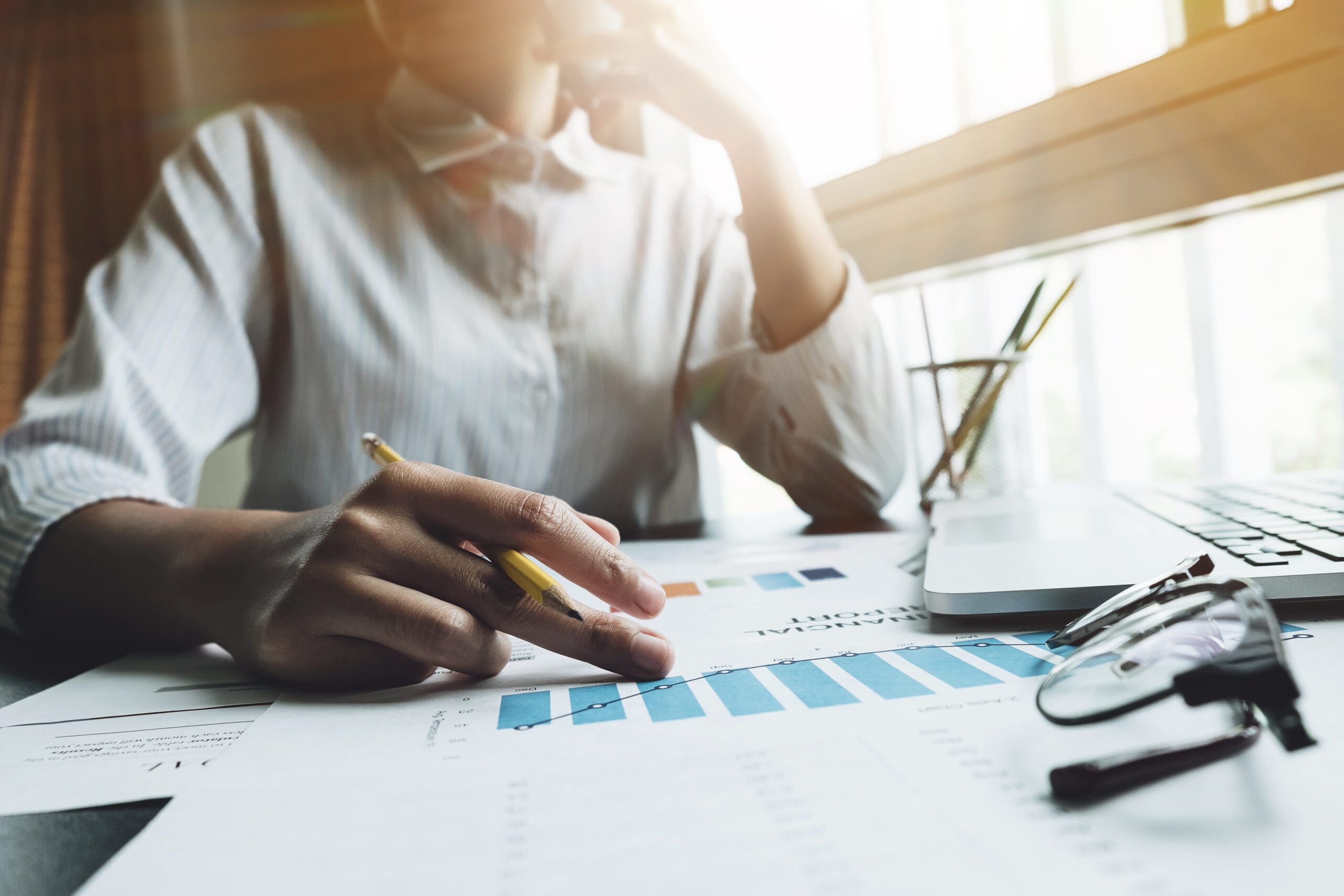According to research firm IHL Group, the total cost of stockouts and overstocks for businesses in 2023 was projected to be $1.77 trillion due largely to ineffective fulfillment planning, processes, reporting, and automation.
These staggering numbers reflect the importance of order fulfillment software, which lets you streamline your delivery service from the moment you receive an order to the second it’s at your customer’s doorstep.
With many options on the market, it can be hard to decipher which order fulfillment software is best for your needs. We have 12 considerations to remember when choosing the right software for your business’s needs — and our top recommendation.
Learn what you should look for in order fulfillment software to simplify your warehouse operations, optimize service levels, and improve your bottom line.
What Is Order Fulfillment Software?
Order fulfillment software connects your sales channels to your supply chain and allows you to manage your fulfillment digitally, like your eCommerce sales and marketing.
Fulfillment software connects to your tech stack through direct integration or API integration. Rather than becoming an additional platform to manage, it supplements and enhances your current processes.
Benefits of Order Fulfillment Software
eCommerce sales channels are digital by design, but most people don’t think of order fulfillment systems when they think of supply chain and fulfillment. However, the supply chain must have a digital connection point to keep up with eCommerce sales growth.

One way this is accomplished is through inventory distribution, which means stocking your inventory in multiple locations to lower TNT, which benefits your business in these distinct ways:
- Meet Expectations for Shipping Speed – Your customers expect fast shipping. Distributing inventory enables the fast shipping that today’s eCommerce-first environment has normalized. It allows for real-time order tracking, automatic updates, and improved customer satisfaction.
- Control Fulfillment and Delivery Costs – If you’re fulfilling orders from a single warehouse, you’re likely sending long-zone shipments to reach many customers. Long-zone shipments increase delivery costs and slow down delivery speed. Often, if you don’t have your inventory distributed, you end up relying on next-day air shipments to meet customer expectations, which can be prohibitively expensive.
- Reduce Human Error – Order fulfillment systems minimize your need for manual data entry and, in the process, significantly reduce the risk of human error. This improvement in accuracy leads to fewer order mistakes and ensures that your customers receive the correct products promptly.
- Save Time Through the Use of Automation – Areas you can automate with fulfillment software include order processing, inventory management, and shipping. The added efficiency lets you focus more on strategic growth rather than getting bogged down in day-to-day operational tasks.
- Integration – Many modern order fulfillment software streamlines your sales channel management by integrating directly with eCommerce platforms like Shopify, major marketplaces like WalMart Marketplace and Amazon, as well as Order Management Systems (OMS.)

12 Things to Look for in an Order Fulfillment Software
Not all fulfillment software is created equally. Before investing time and resources in adding a new platform to your tech stack, check that the order fulfillment software in question has the following capabilities:
1. Automatic Order Routing
New orders get sent automatically to the warehouse for fulfillment. This speeds up the fulfillment shipping process and eliminates cumbersome manual processes.
Look for smart order orchestration that routes orders to the warehouse closest to the end customer for the shortest possible time in transit (TNT).
2. Inventory Management
Having complete oversight across all of your storage facilities is crucial, as it will allow you to allocate your resources to accommodate any shifts in demand. Conducting consistent and precise inventory audits is also key to reducing shrinkage from loss or theft.
3. Proactive Stock Monitoring
Make sure your system is equipped with real-time notifications for depleting stock levels to help with timely replenishment, particularly for high-demand items. This proactive approach prevents stockouts, in the process avoiding lost sales and keeping customers satisfied. The order fulfillment software should also include expiry date tracking to avoid shrinking due to products expiring.
4. Searchable and Editable Orders
A flexible order fulfillment software needs to let you search for and modify orders easily. This capability is crucial for last-minute changes to customer orders, like address updates or product swaps. It’s common to get follow-up messages from customers who entered an address or other details of their order incorrectly. Being able to quickly and easily edit orders is a vital part of the customer service experience.
5. Delivery Tracking
Tracking numbers automatically sync with sales orders, and the software immediately sends customers shipping confirmations.
Today’s consumers value visibility and reliability. In fact, a survey by UPS Capital revealed that 74% of today’s consumers expect real-time tracking information on online purchases.
6. View Invoices
Having easy access to view and manage invoices will help to simplify managing finances and accounting. Your software needs to track billing, payments, and charges associated with fulfillment services. This goes a long way to make sure that your financial records are accurate and transparent.
7. Process Returns
60% of customers say that a good returns policy is important when they’re making an online purchase. And 72% of customers expect a refund within five days of returning a product.
That’s why you need software that can help you to efficiently manage all parts of the return process. It needs to be easy to return products from the customer’s end, and it needs to be easy for you to manage inventory adjustments and process refunds on your end.
8. In-Depth Reporting
Order fulfillment software comes equipped with dashboards and customizable reports to track key performance indicators (KPIs) in real time. This level of visibility into operations offered by reporting can help you to:
- Optimize inventory levels
- Avoid excess stock, which unnecessarily takes up capital and storage space
- Minimize the risk of stockouts
- Identify patterns in shipping data to negotiate better rates
- Reduce overall shipping costs
9. Integrate with eCommerce platforms
Seamless integration with an eCommerce fulfillment software is nonnegotiable. You need to be able to effortlessly sync orders, inventory, and customer data between systems, which can be done using order fulfillment software with seamless eCommerce integration.
The results? Reduced manual data entry and human errors, providing customers with essential information like real-time stock data.
10. See Real-Time Rates and Print Shipping Labels
Choose software that generates shipping labels and provides real-time carrier rates. It saves time, reduces errors, and helps you get the best shipping rates, which allows you to pass the savings on to your customers.
11. Custom Order Settings
Today’s customers can have specific requirements, such as to leave orders with a certain neighbor (or which ones to avoid). An order fulfillment software with a custom notes field allows you to input specifics for customers just once — such as delivery location requirements — and remember them for every delivery.
12. Order Orchestration
Opt for a system with advanced order orchestration. This means that orders get automatically routed to the optimal warehouse based on inventory, distance to the customer, labor capacity, and even weather conditions. This feature makes sure you’re always fulfilling from the best location and lets you balance efficiency with customer satisfaction.

Benefits of Fulfillment Reporting
Many merchants regularly access sales and marketing reports but overlook fulfillment and supply chain reporting. However, fulfillment reporting can offer powerful insights to drive more efficiency and profitability, including:
- SKU level profitability – Fulfillment costs and storage costs play an important role in profitability. Measuring the full cost of goods sold (COGS) all the way to your customer’s doorstep will help you determine which SKUs to prioritize.
- SKU velocity – Monitoring sales velocity at the SKU level will help you determine the ideal reorder quantities to balance bulk supplier discounts with healthy inventory turns.
- Geographic order distribution – You may learn that most of your customers are concentrated on the East Coast. If you’ve been importing into a West Coast port, you might consider re-routing shipments to an East Coast port closer to lower transit times.
Analytics and Continuous Improvement
Your order fulfillment software should incorporate technology and analytics to remain current and provide you with accurate data.
Analytics
Access to accurate and up-to-date analytics is key to optimizing your operations and staying ahead of the competition. Good order fulfillment software will include advanced analytical tools and comprehensive reporting key features that help you to make informed decisions.
It lets you:
- Identify trends
- Pinpoint inefficiencies
- Uncover opportunities for cost savings
- Monitor customer satisfaction
- Track important statistics like order fulfillment accuracy and return rates
Continuous Improvement
If you want to survive and thrive in the competitive fulfillment sector, you need to be constantly evolving and making your processes more efficient.
Once you’re armed with the insightful analytics and metrics that your order fulfillment software can provide, you can continuously hone your operational strategies. This iterative process of analysis, adjustment, and improvement helps keep your business agile and responsive in the competitive eCommerce landscape.
About Ware2Go’s Order Fulfillment Software
Ware2Go’s fulfillment software has over 80 direct connections to sales channels, ERPs, and order management systems. Its open API enables unlimited integrations and webhook capabilities.
FulfillmentVu is the single connection point between all sales channels and Ware2Go’s full-service fulfillment network. The distributed warehouse network is flexible and adaptable in order to scale quickly when demand shifts or channel requirements change. Key features of the eCommerce fulfillment software include:
- Connected Channels – Customize your merchant portal to easily link with any sales channel, including eCommerce platforms and marketplaces, for streamlined management.
- Warehouse Management – FulfillmentVu’s warehouse management capabilities allow for third-party billing, lot and expiry tracking, serialization, and more.
- Transport Flexibility – Ware2Go’s flexible fulfillment network is capable of managing a wide variety of transportation options, from small parcels to less than load (LTL) and full truckload (FTL.)
- Integrations –Ware2Go has over 250 integrations, including major platforms like NetSuite, Shopify, and Amazon.
- B2B and B2C Support – Caters to both business models with seamless integration and fulfillment processes tailored to each.
- Personalized Service – Ware2Go provides dedicated support to fine-tune your fulfillment strategy to your specific needs.
- Lot Tracking and Expiry Date Prioritization – Prioritize shipments based on expiry dates to ensure product freshness and reduce waste.
- Automated Delivery Tracking – Offers real-time updates on shipments, keeping both you and your customers informed.
- Reporting – Access to comprehensive reports and analytics for informed decision-making and continuous improvement.
- Inventory Management – Sophisticated tools to adjust for your overflow, seasonal, or otherwise fluctuating inventory needs, preventing stockouts and overstocking while optimizing space.
FulfillmentVu’s advanced capabilities connect Ware2Go’s nationwide network to enable 1- to 2-day delivery across the US. The network is supported by Ware2Go’s industry-leading service level agreements (SLAs), which guarantee 99% accurate and on-time fulfillment, putaway time on inbounds, and same-day fulfillment on orders received before the warehouse cutoff time.
Why Ware2Go’s FulfillmentVu Is the Best Order Fulfillment Software for Your eCommerce Business
Ware2Go could be the game-changer that your eCommerce business needs. Our blend of speed, efficiency, and dependability can help to streamline your supply chain and significantly enhance your customer satisfaction.
Merchants who begin offering 2-day shipping see a 25% increase in cart conversions, and a whopping 84% of consumers say they won’t repurchase from a brand after a poor delivery experience. Choose a fulfillment provider that offers a guarantee to avoid disappointed customers.
Discover how to win customers for life with faster fulfillment with the Ware2Go eBook.




